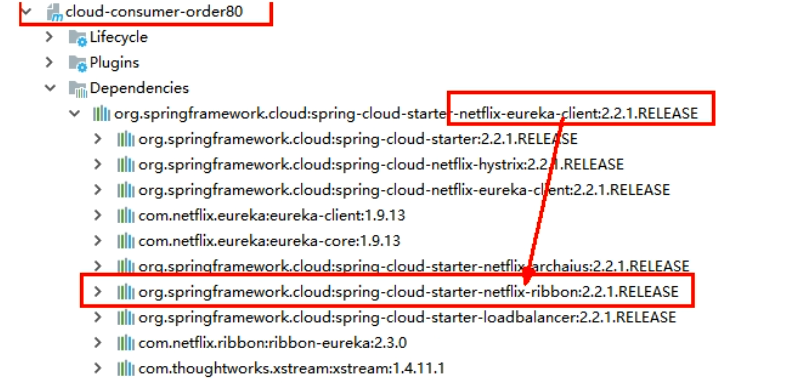Ribbon 负载均衡服务调用
一、概述
1、是什么?
Spring Cloud Ribbon 基于 Netflix Ribbon 实现的一套客户端、负载均衡工具。
Ribbon 是 Netflix 发布的开源顶目,主要功能是提供客户端的软件负载均衡算法和服务调用。Ribbon 客户端组件提供一系列完善的配置项如连接超时,重试等。简单的说,就是在配置文件中列出 Load Balancer(简称LB)后面所有的机器,Ribbon 会自动的帮助你基于某种规则(如简单轮询,随机连接等)去连接这些机器。我们很容易使用 Ribbon 实现自定义的负载均衡算法。
Ribbon目前也进入维护模式。
2、做什么?
LB负载均衡(Load Balance)是什么?
就是将用户的请求平摊的分配到多个服务上,从而达到系统的HA(高可用)。常见的负载均衡有软件Nginx,LVS,硬件F5等。
Ribbon本地负载均衡客户端 VS Nginx服务端负载均衡区别
- Nginx是服务器负载均衡,客户端所有请求都会交给nginx,然后由nginx实现转发请求。即负载均衡是由服务端实现的。
- Ribbon本地负载均衡,在调用微服务接囗时候,会在注册中心上获取注册信息服务列表之后缓存到JVM本地,从而在本地实现RPC远程服务调用技术。
一句话:Ribbon 能做负载均衡+RestTemplate调用
二、Ribbon负载均衡演示
前面我们讲解过了80通过轮询负载访问8001/8002
1、Ribbon在工作时分成两步
第一步:先选择EurekaServer,它优先选择在同一个区域内负载较少的Server。
第二步:再根据用户指定的策略,在从Server取到的服务注册列表中选择一个地址。
其中Ribbon提供了多种策略:比如轮询、随机和根据响应时间加权。官网地址

2、getForObject方法/getForEntity方法

3、postForObject/postForEntity方法

三、Ribbon核心组件IRule
IRule:根据特定算法从服务列表中选取一个要访问的服务

1、策略描述
| 策略名 | 策略声明 | 策略描述 | 实现说明 |
| BestAvailableRule | public class BestAvailableRule extends ClientConfigEnabledRoundRobinRule | 选择一个最小的并发请求的server | 逐个考察Server,如果Server被tripped了,则忽略,在选择其中ActiveRequestsCount最小的server |
| AvailabilityFilteringRule | public class AvailabilityFilteringRule extends PredicateBasedRule | 过滤掉那些因为一直连接失败的被标记为circuit tripped的后端server,并过滤掉那些高并发的的后端server(active connections 超过配置的阈值) | 使用一个AvailabilityPredicate来包含过滤server的逻辑,其实就就是检查status里记录的各个server的运行状态 |
| WeightedResponseTimeRule | public class WeightedResponseTimeRule extends RoundRobinRule | 根据相应时间分配一个weight,相应时间越长,weight越小,被选中的可能性越低。 | 一个后台线程定期的从status里面读取评价响应时间,为每个server计算一个weight。Weight的计算也比较简单responsetime 减去每个server自己平均的responsetime是server的权重。当刚开始运行,没有形成statas时,使用roubine策略选择server。 |
| RetryRule | public class RetryRule extends AbstractLoadBalancerRule | 对选定的负载均衡策略机上重试机制。 | 在一个配置时间段内当选择server不成功,则一直尝试使用subRule的方式选择一个可用的server |
| RoundRobinRule | public class RoundRobinRule extends AbstractLoadBalancerRule | roundRobin方式轮询选择server | 轮询index,选择index对应位置的server |
| RandomRule | public class RandomRule extends AbstractLoadBalancerRule | 随机选择一个server | 在index上随机,选择index对应位置的server |
| ZoneAvoidanceRule | public class ZoneAvoidanceRule extends PredicateBasedRule | 复合判断server所在区域的性能和server的可用性选择server | 使用ZoneAvoidancePredicate和AvailabilityPredicate来判断是否选择某个server,前一个判断判定一个zone的运行性能是否可用,剔除不可用的zone(的所有server),AvailabilityPredicate用于过滤掉连接数过多的Server。 |
2、如何替换
修改cloud-consumer-order80
注意配置细节:官方文档明确给出了警告:这个自定义配类不能放在@ComponentScan所扫描的当前包下以及子包下,否则我们自定义的这个配置类就会被所有的Ribbon客户端所共享,达不到特殊化定制的目的了。
新建package,上面包下新建MySelfRule规则类
package com.atguigu.myrule; import com.netflix.loadbalancer.IRule; import com.netflix.loadbalancer.RandomRule; import org.springframework.context.annotation.Bean; import org.springframework.context.annotation.Configuration; @Configuration public class MySelfRule { @Bean public IRule myRule(){ return new RandomRule();//定义为随机 } }
主启动类添加@RibbonClient
package com.atguigu.springcloud; import com.atguigu.myrule.MySelfRule; import org.springframework.boot.SpringApplication; import org.springframework.boot.autoconfigure.SpringBootApplication; import org.springframework.cloud.netflix.eureka.EnableEurekaClient; import org.springframework.cloud.netflix.ribbon.RibbonClient; @EnableEurekaClient @SpringBootApplication @RibbonClient(name = "CLOUD-PAYMENT-SERVICE",configuration = MySelfRule.class) public class OrderMain80 { public static void main(String[] args) { SpringApplication.run(OrderMain80.class,args); } }
测试:http://localhost/consumer/payment/get/1
还有一种配置文件配置策略的方式:参考此文章
三、Ribbon负载均衡算法

四、手写本地负载均衡器
80订单微服务改造
1、ApplicationContextBean去掉@LoadBalanced
2、LoadBalancer接口
package com.atguigu.springcloud.lb; import org.springframework.cloud.client.ServiceInstance; import java.util.List; public interface LoadBalancer { //收集服务器总共有多少台能够提供服务的机器,并放到list里面 ServiceInstance instances(List<ServiceInstance> serviceInstances); }
3、MyLB
package com.atguigu.springcloud.lb; import org.springframework.cloud.client.ServiceInstance; import org.springframework.stereotype.Component; import java.util.List; import java.util.concurrent.atomic.AtomicInteger; @Component public class MyLB implements LoadBalancer { private AtomicInteger atomicInteger = new AtomicInteger(0); //坐标 private final int getAndIncrement() { int current; int next; do { current = this.atomicInteger.get(); next = current >= 2147483647 ? 0 : current + 1; } while (!this.atomicInteger.compareAndSet(current, next)); //第一个参数是期望值,第二个参数是修改值是 System.out.println("*******第几次访问,次数next: " + next); return next; } @Override public ServiceInstance instances(List<ServiceInstance> serviceInstances) { //得到机器的列表 int index = getAndIncrement() % serviceInstances.size(); //得到服务器的下标位置 return serviceInstances.get(index); } }
4、OrderController
package com.atguigu.springcloud.controller; import com.atguigu.springcloud.entities.CommonResult; import com.atguigu.springcloud.entities.Payment; import com.atguigu.springcloud.lb.LoadBalancer; import lombok.extern.slf4j.Slf4j; import org.springframework.cloud.client.ServiceInstance; import org.springframework.cloud.client.discovery.DiscoveryClient; import org.springframework.http.ResponseEntity; import org.springframework.web.bind.annotation.GetMapping; import org.springframework.web.bind.annotation.PathVariable; import org.springframework.web.bind.annotation.RestController; import org.springframework.web.client.RestTemplate; import javax.annotation.Resource; import java.net.URI; import java.util.List; @RestController @Slf4j public class OrderController { // public static final String PAYMENT_URL = "http://localhost:8001"; public static final String PAYMENT_URL = "http://CLOUD-PAYMENT-SERVICE"; @Resource private RestTemplate restTemplate; @Resource private LoadBalancer loadBalancer; @Resource private DiscoveryClient discoveryClient; @GetMapping("/consumer/payment/create") public CommonResult<Payment> create(Payment payment) { return restTemplate.postForObject(PAYMENT_URL + "/payment/create", payment, CommonResult.class); //写操作 } @GetMapping("/consumer/payment/get/{id}") public CommonResult<Payment> getPayment(@PathVariable("id") Long id) { return restTemplate.getForObject(PAYMENT_URL + "/payment/get/" + id, CommonResult.class); } @GetMapping("/consumer/payment/getForEntity/{id}") public CommonResult<Payment> getPayment2(@PathVariable("id") Long id) { ResponseEntity<CommonResult> entity = restTemplate.getForEntity(PAYMENT_URL + "/payment/get/" + id, CommonResult.class); if (entity.getStatusCode().is2xxSuccessful()) { // log.info(entity.getStatusCode()+"\t"+entity.getHeaders()); return entity.getBody(); } else { return new CommonResult<>(444, "操作失败"); } } @GetMapping(value = "/consumer/payment/lb") public String getPaymentLB() { List<ServiceInstance> instances = discoveryClient.getInstances("CLOUD-PAYMENT-SERVICE"); if (instances == null || instances.size() <= 0) { return null; } ServiceInstance serviceInstance = loadBalancer.instances(instances); URI uri = serviceInstance.getUri(); return restTemplate.getForObject(uri + "/payment/lb", String.class); } }
5、测试
http://localhost/consumer/payment/lb

